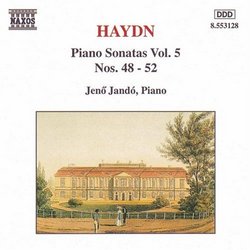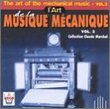| All Artists: Franz Joseph Haydn, Jenö Jandó Title: Haydn: Piano Sonatas Vol. 5 Members Wishing: 0 Total Copies: 0 Label: Naxos Original Release Date: 1/1/1995 Re-Release Date: 12/13/1994 Genre: Classical Styles: Forms & Genres, Sonatas, Historical Periods, Classical (c.1770-1830) Number of Discs: 1 SwapaCD Credits: 1 UPC: 730099412827 |
Search - Franz Joseph Haydn, Jenö Jandó :: Haydn: Piano Sonatas Vol. 5
 | Franz Joseph Haydn, Jenö Jandó Haydn: Piano Sonatas Vol. 5 Genre: Classical
|
Larger Image |
CD DetailsSimilar CDs
|
CD ReviewsGreater than Mozart, Inspiration for Beethoven Micromegas | Ada, OK | 02/17/2008 (5 out of 5 stars) "Haydn's sonatas aren't played as often as they should, either in performance or on CD. Yet having sampled a wide variety of them (particularly the ones on this disc), it is clear that the piano sonata was an intimate voice for Haydn's art, much more so than for Mozart (brilliant as those works are). Haydn's sonatas sparkle with wit, fluency, drama, fire, and a sense that Beethoven is waiting in the wings. I often here snatches of the early Beethoven sonatas, such as No.8, 11, 13 and 14 here--though, of course, when we hear these sonatas, we are probably hearing snatches of Haydn! The works here are staggering in their interest and musicality. Each one is a masterpiece, at first unassumingly so, but with a few listens the incredible range and mastery completely overtakes you. This is not the voice of the symphonies or the quartets exactly, though you can still "hear" that Haydn here. However, there is a darkness and intimacy that those works sometimes lack, and a sense of speaking directly to someone close--in the form of an intimate 18th century letter to a treasured friend, one to whom the formal niceties can safely be put aside to speak of the inner workings of the mind and heart. Jando is a marvelous interpreter of Haydn's sonatas, letting them speak for themselves without making any show about their difficulty or interpretation (though his interpretations are brilliant--not at all artless or timid). We owe him a great debt of gratitude for recording the entire series, which I eagerly await to hear (several volumes to go!)." Great performance with style J. An | S.F. Bay Area, CA | 02/25/2007 (5 out of 5 stars) "Mr. Jando puts life into these Haydn sonatas with style. It is a great CD for all students and teachers or anyone who likes piano music." Exploring the Haydn Sonatas -- Nos 48 -- 52 Robin Friedman | Washington, D.C. United States | 09/22/2009 (5 out of 5 stars) "In 1780, Haydn published the third compilation of a set of six piano sonatas. He dedicated the set to two musically gifted sisters, Caterina and Marianna Auenbrugger. The set is sometimes referred to simply as the "Auenbrugger" sonatas. The earlier two sets of sonatas are presented in other CDs by Jeno Jando as part of his cycle of the complete Haydn sonatas on Naxos while five of the six Auenbrugger sonatas are included on the disk I am reviewing here. The remaining sonata from this set, the sonata no. 33 in c minor, Hob. 33,which appears to be composed earlier than its companions, appears on a separate CD (CD 5 in the Jando's Naxos box set, vol 7 in Jando's individual CDs of the Haydn sonatas).
These sonatas appear relatively far along in Haydn's output and they are performed with some frequency. (Marc-Andre Hamelin, for example, virtuosically performs three of them in his recently recorded two sets of Haydn sonatas). They were composed expressly for the piano rather than for the harpsichord. The sonatas are integrated wholes with their related movements rather than a compilation of somewhat interchangeable movements as in a suite. These works epitomize the early classical style and are full of galanterie, variety, and a large degree of feeling. Several of these sonatas include rich, meditative slow movements. Jando plays these sonatas without over sentimentalizing or overdoing them. His Haydn cycle constitutes an excellent, inexpensive way to enjoy the sonatas in detail and to follow their development over time. Of the six Auenbrugger sonatas, four are in the major key and two in the minor, including one on this CD. Each of the sonatas is in three movements. Here are some brief comments on each of the sonatas on the disk. The sonata no. 48 in C major, Hob. 35 is frequently performed and studied. It is often compared to Mozart's so called "easy" sonata in C, K. 545, but Haydn's piece is substantially larger in scope. The opening allegro con brio features a march-like, outgoing theme played and varied over a repeated Alberti bass. It has the first of several lovely slow movements in this set, as it begins with a rolled chord and moves from a stately, restrained theme to music which flows and sings. The work ends with a lively allegro which includes a brief interlude in c minor. Beethoven used the unusual key of c-sharp minor in his famous "Moonlight" sonata, and Haydn uses this key to different effect in his sonata no. 49, Hob. 36. The opening movement begins with an angular, bleak theme in octaves in the piano's lower register followed by a contrasting passage in the major key using essentially similar material. The second movement, which Haydn would borrow later in the set, is contrastingly light and marked Scherzando. The sonata returns to and remains in the minor key in its menuet finale. The sonata no. 50 in D major, Hob.37 is also frequently performed with its broad, vigorous, and rhythmic allegro con brio opening movement. But the heart of the work lies in the contrasting middle movement, marked Largo e sostenuto.. This movement has been compared to a Baroque sarabande. It features solemn chordal harmonies and the use of counterpoint. The presto finale follows without pause, as is frequent in the Haydn sonatas. The little movement is marked innocentemente, to contrast with the two ambitious movements which proceeded it, and it features a singing theme twice interrupted by varying episodes. The sonata no. 51 in E flat major is less frequently played than others in this set. But it is a lovely work with an opening allegro moderato which begins quietly and develops and varies in its course a single short theme. This sonata too centers on an adagio which unfolds with lyric eloquence and concludes with a long cadence. The allegro finale follows without pause and, as is the opening movement, is largely based upon a single theme. The final sonata in this group, no. 52 in G major, opens with the same theme that Haydn used in the Scherzando movement of the c-sharp minor sonata. Haydn felt he needed to apologize for the similarity, even while he testily explained that he used the same material to different musical ends. The middle movement is a florid adagio, full of trills, ornaments, and recitif material. The sonata ends with a loud, lively prestissimo which features a big passage in octaves before it comes to a surprise, quiet ending. Robin Friedman" |

 Track Listings (15) - Disc #1
Track Listings (15) - Disc #1

